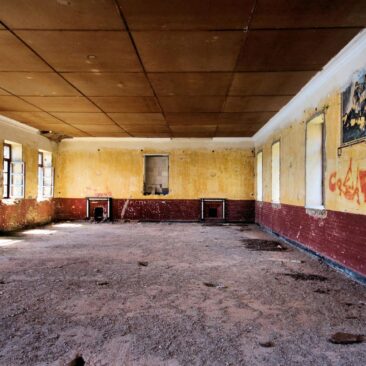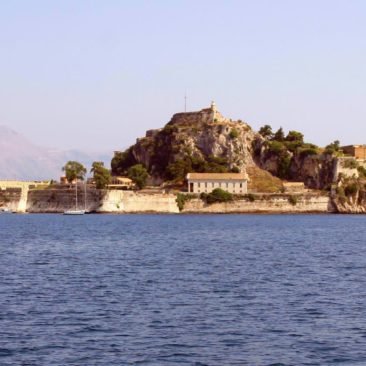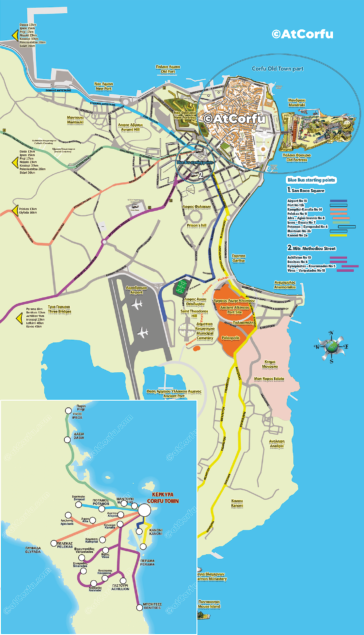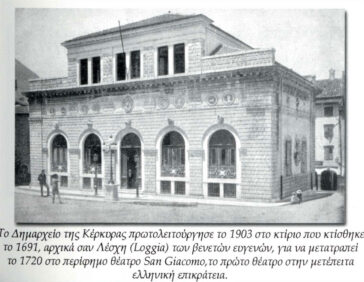Last updated on July 6th, 2025 at 05:40 pm
Corfu Old Fortress Location
The Corfu Old Fortress is situated on a small rocky peninsula, a natural stronghold on the eastern border of the medieval citadel of Corfu.
Originally, it was a natural promontory that protected the inhabitants from the 5th century AD onwards, when the city of Corfu was relocated here following the destruction of the ancient city by the Visigoths. It was on this site that the people constructed the first medieval city, known as the Citadel.
Undoubtedly, the Corfu Old Fortress is the most significant monument and a must-visit attraction in Corfu Town.
The compact medieval city within the fortress has been separated from the mainland since the Venetian era by a narrow moat. However, today, visitors can easily access it via the bridge constructed by the Venetians.
The Byzantines had already utilized this promontory as a natural fortification for the early medieval town from the 5th century CE. Between 1300 and 1700, the Venetians further fortified it to safeguard the island from potential invaders.
Its strategic position along the coastline, along with its elevated vantage points, facilitated the early detection of approaching boats on the horizon, providing ample time to alert the island’s inhabitants to potential threats. During your visit, you will have the opportunity to view some of the original weapons used for defense and enjoy breathtaking views of the sea.
You will be amazed at how conveniently located the Old Fortress is to the city, making it easily accessible regardless of your mode of transportation. You can even walk there if you have the entire day to spare!
Fortifications
The Corfu Old Fortress features two peaks, or ‘koryfes’ (also spelled ‘korfes’): one in the East, where the Sea Tower was originally constructed by the Byzantines around the 7th century AD, and the Western peak, known as the Land Tower.
During the 8th century AD, the Byzantines fully transformed it into a fortress, encompassing the entire small medieval town along with military barracks.
The rocky stronghold received continuous reinforcement, either by the Angevins or later by the Venetians, to defend against the numerous invasions during the Middle Ages. Gradually, the town expanded around it.
In response to the threat posed by the Ottomans, the Venetians bolstered their fortifications, extended the bastions, and excavated a moat known as the ‘kontra fossa,’ effectively isolating the fortress from the mainland and turning it into an island.
During the final period of Venetian rule, the area in front of the Fortress underwent a significant transformation as nearly 3,000 houses were demolished. This was done for defensive purposes and is how Corfu acquired its spacious Esplanade square that we see today.
This strategic development allowed the Venetians to establish an impenetrable triple line of defense, both on land and from the sea.
Buildings inside the Old Fortress
Inside the old fortress, in 1840, the Doric church of St. George was constructed by the British as a garrison church.
During the Venetian era, numerous buildings were erected as it functioned as a small town. However, most of these structures did not survive and have since been demolished. The ones that remain are primarily those built by the British.
Of particular note are the central gate, the bastions of Savornian, Martinengo, and Mandraki, the Land Tower in the West, and the Sea Tower in the East. Other significant structures include the English hospital, the English barracks, the clock tower, and the lighthouse.
Within the fortress, a prison built by the Venetians in 1786, later expanded by the British, is still in place. Additionally, you can find the military chapel and two English barracks from 1850.
The lower part of the British military hospital now houses the Music Department of the Ionian University.
Furthermore, the fortress serves as the repository of historical records spanning over six centuries of history, a Byzantine collection featuring sculptures and images from the Byzantine era, and a public library.
At the entrance of the old fortress on the upper Esplanade, you’ll encounter the statue of Prussian Marshal Johann Matthias von der Schulenburg, crafted by the Venetians in his honor for successfully repelling the Turkish invasion of 1716.
Today, the Corfu Old Fortress stands as a masterpiece of architectural and fortification art, offering visitors the finest panoramic views of the city, its harbor, and the sea extending to the mountains of Epirus.
The British Hospital
One of the significant structures that still stands within the Corfu Old Fortress is the British hospital.
In fact, there were two buildings: the larger one situated at the upper level, positioned between the Sea Tower and the Land Tower, and the smaller one at a lower level. Here, we will focus on the larger building.
The British colonists constructed this building in 1814 to serve as Corfu town’s second hospital since the larger hospital was situated in the Liston area.
The Corfu Old Fortress Hospital had the capacity to treat up to 120 patients. Throughout its history, it functioned primarily as a hospital. Initially, it served during the British colonial rule of the island, then throughout the 19th century, and later during both World War I and World War II.
However, there was a dark period for the building and the city during the occupation by Axis forces. First, the Italians, and later the Germans, used it as their headquarters. Executions and tortures within its walls transformed this life-saving facility into a place of death and anguish.
A hole in its floor, known as the “kokkaliera” or “bone hole,” was used by occupiers to dispose of the bodies of executed individuals or those who died after torture.
Following the German occupation, the Greek army took control of the building, sealed the bone hole, and used it for bureaucratic army services.
Regrettably, the building is now abandoned. It has given rise to various legends and is often considered one of the most haunted buildings in Greece. Many claim to have experienced paranormal activity within its walls, including sightings of executions, dark figures at the windows, screams, voices pleading for help, and even gunfire.
There is also a document in a local newspaper from 1982 that discusses similar rumors. It is our belief that these legends have emerged from the fear generated by the eerie atmosphere inside an abandoned building, characterized by its vast empty rooms, broken doors, and windows through which the wind’s howling sounds akin to screams. The building’s almost collapsed roof adds to the overall sense of unease it evokes.
Corfu Old Fortress Opening Hours
8:00 AM to 8:00 PM
But first, let’s clarify a few things.
The Corfu Old Fortress today resembles a small island, adorned with historic buildings, churches, old prisons, barracks, museums, and public services. It houses various offices, including the Ephorate of Antiquities of Corfu, departments of the Ionian University, military services, and even a café bar, among others.
Consequently, it’s challenging to provide precise opening hours since they vary, and certain government buildings may not be accessible to visitors.
However, the Old Fortress area remains open to the public as its main entrance never closes, allowing anyone to enter and explore the historical monuments.
Most museums within the fortress are open to the public from 8:00 AM to 8:00 PM.
It’s important to note that the Music Department of the Ionian University is not open to the public; it is exclusively accessible to students.
More about Corfu
Corfu Blue Bus Routes Map (PDF)
Download this free, full-size PDF map of the Blue Bus route network, featuring all routes, major stops, and central pick-up points in Corfu Town.
Festivals and Panigiria in the Villages of Corfu
Experience authentic Corfiot culture at traditional village festivals (panigiria) with local food, music, and heartfelt celebrations year-round.
Gossip with a Twist: Corfu’s Petegoletsa Tradition
On the last Thursday of the carnival, Corfu has revived a very old tradition, an integral part of the Corfu carnival, which dates from the years of Venetian rule. It is called the Petegoletsa.
Corfu Carnival: Echoes of a Venetian Past
The Ancient celebrations in early spring that took place in honor of Dionysus, god of wine and fun, hoping for a good harvest and successful husbandry, are the forerunners of today’s carnival in Greece.
Corfu Town Hall: The San Giacomo Theatre
Nestled at the vibrant crossroads of Eugeniou Voulgareos and M. Theotoki streets, Corfu Town Hall stands as an architectural masterpiece with an intriguing history.
The Palace of St. Michael and St. George
During the era of the British rule in Corfu, High Commissioner Sir Frederick Adams in 1819 decided to build the Palace of Saint Michael and George
























Comments